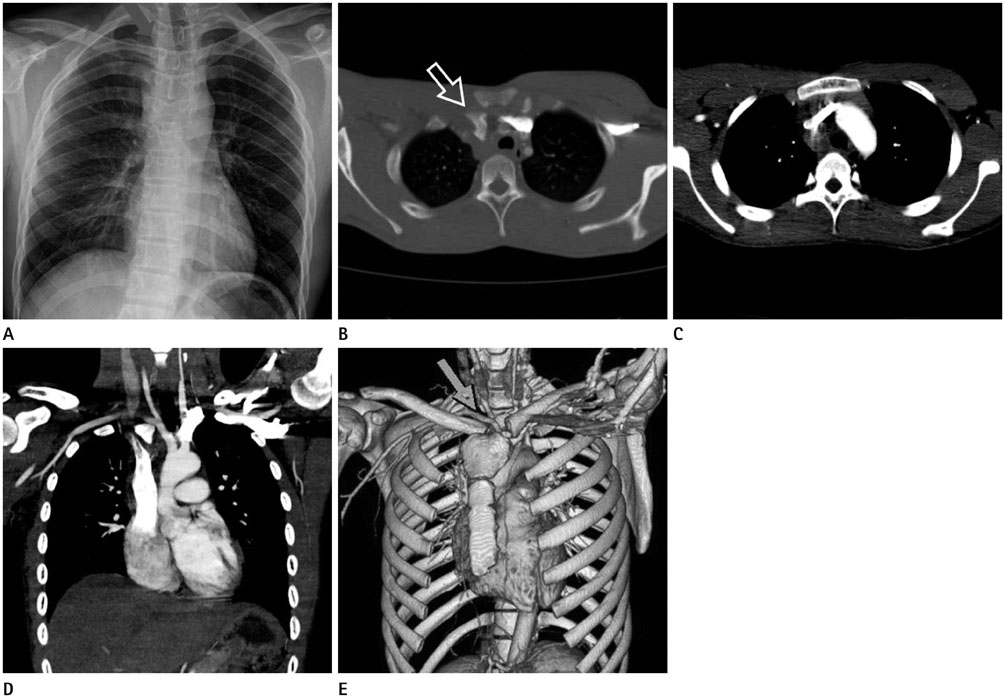J Korean Soc Radiol.
2015 Feb;72(2):128-130. 10.3348/jksr.2015.72.2.128.
Posterior Sternoclavicular Dislocation: A Case Report
- Affiliations
-
- 1Department of Radiology, Incheon St. Mary's Hospital, The Catholic University of Korea College of Medicine, Incheon, Korea. kjrad@catholic.ac.kr
- KMID: 2002809
- DOI: http://doi.org/10.3348/jksr.2015.72.2.128
Abstract
- Traumatic sternoclavicular joint dislocation is an uncommon injury, and posterior sternoclavicular dislocation occurs less frequently compared to anterior sternoclavicular dislocation. However, this type of dislocation has the potential for serious complications due to compression or laceration of the mediastinal structures. The diagnosis can be difficult using plain radiographs alone due to radiographic-anatomic superimposition. Therefore, posterior sternoclavicular dislocation is easily missed at the initial clinical evaluation. Contrast-enhanced computed tomography is required for a definite diagnosis and to assess associated mediastinal injuries.
Figure
Reference
-
1. Salgado RA, Ghysen D. Post-traumatic posterior sternoclavicular dislocation: case report and review of the literature. Emerg Radiol. 2002; 9:323–325.2. Khorashadi L, Burns EM, Heaston DR, Warme WJ, Richardson ML. Posterior dislocation of the sternoclavicular joint. Radiol Case Rep. 2011; 6:439.3. Doss A, Lang IM, Roberts I, Bell MJ, Smith TW. Posterior sternoclavicular joint dislocation in children-role of spiral computed tomography. Pediatr Emerg Care. 2005; 21:325–326.4. Galanis N, Anastasiadis P, Grigoropoulou F, Kirkos J, Kapetanos G. Judo-related traumatic posterior sternoclavicular joint dislocation in a child. Clin J Sport Med. 2014; 24:271–273.5. Kim DH, Kim DH, Kang SK, Lee EC. Treatment of traumatic posterior dislocation of the sternoclavicular joint: a case report. J Korean Fract Soc. 2013; 26:56–59.6. Cope R, Riddervold HO. Posterior dislocation of the sternoclavicular joint: report of two cases, with emphasis on radiologic management and early diagnosis. Skeletal Radiol. 1988; 17:247–250.7. Van Tongel A, De Wilde L. Sternoclavicular joint injuries: a literature review. Muscles Ligaments Tendons J. 2012; 1:100–105.8. Koch MJ, Wells L. Proximal clavicle physeal fracture with posterior displacement: diagnosis, treatment, and prevention. Orthopedics. 2012; 35:e108–e111.
- Full Text Links
- Actions
-
Cited
- CITED
-
- Close
- Share
- Similar articles
-
- Treatment of Traumatic Posterior Dislocation of the Sternoclavicular Joint: A Case Report
- Traumatic Posterior Dislocation of the Sternoclavicular Joint: A case Report
- Treatment of Traumatic Sternoclavicular Joint Anterior Dislocation with a Sternal Fracture
- Ultrasonography in Sternoclavicular Joint Posterior Dislocation in an Adolescent: A Case Report
- Superior Mediastinal Widening from Traumatic Posterior Dislocation of Sternoclavicular Joint: A Case Report


